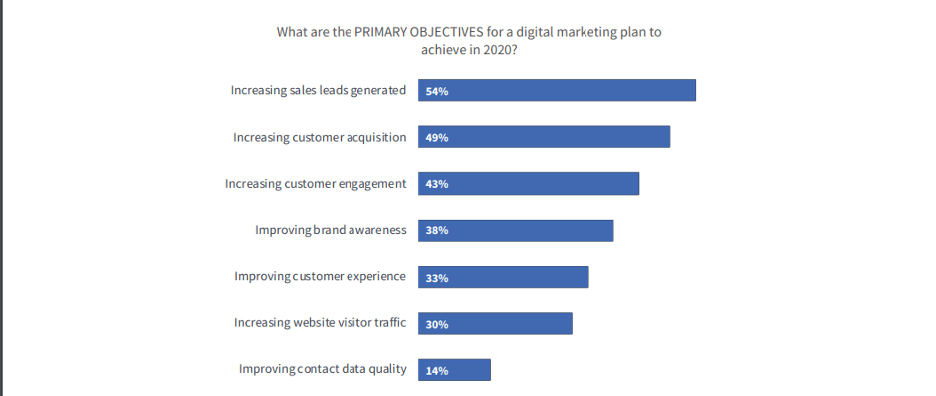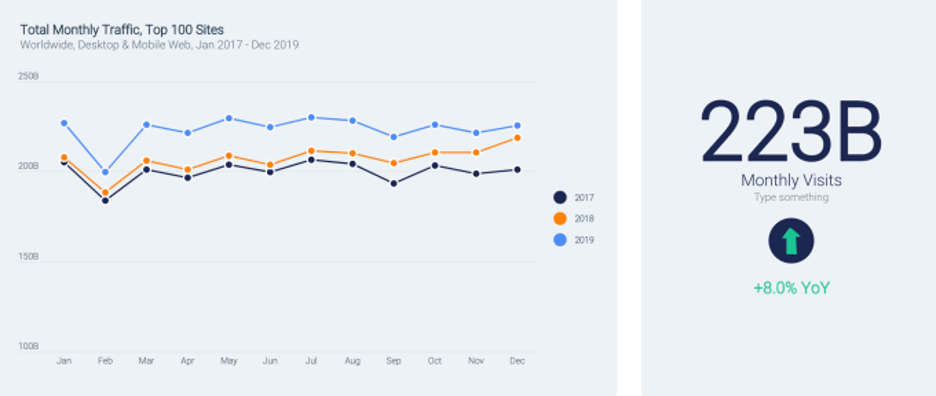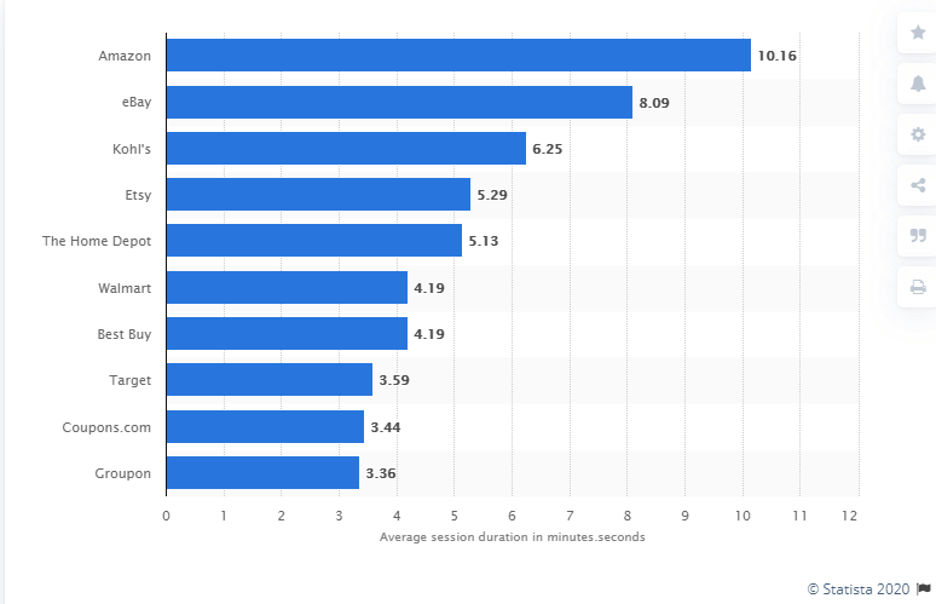If you want to achieve success with your marketing campaign, you’ll have to ensure that your every marketing effort is measurable.
Goals for your marketing campaign can be improving lead generation, increasing brand awareness, boosting your ROI, or anything in between.
Whatever the case, measuring and analyzing your marketing campaign data will provide you with insights that will help you thrive.
This is, naturally, easier said than done. The following measurement and analysis practices will allow you to learn exactly what went right and what wrong with your marketing campaign.
The knowledge you gain this way will improve your future marketing strategies.
KPI Identification for your marketing campaign
If you want to track the performance of your marketing campaign, you’ll first need to identify your key performance indicators (KPIs).
Which indicators you’ll track will depend entirely on your own marketing goals. Over 54% of marketers have the goal of increasing sales leads generated.

Others merely want to improve the customer experience or increase brand awareness.
Whatever your goals are, it’s important to remember to keep them SMART — Specific, Measurable, Achievable, Relevant, and Time-Bound.
That means that your goal cannot simply be “increase brand awareness.” How many people do you want to reach with your campaign, and how quickly?
How can you measure awareness? Can you succeed in this goal? Will it help you reach your ultimate business objectives?
Be as detailed as possible with your goals, and you’ll find it easier to identify your key performance indicators.
With your goals always in mind, identify your marketing channels, then track your KPIs.
Track Website Traffic
Whatever digital marketing campaign you come up with, it surely starts with your website and boosting site traffic.
Your website can serve as an excellent tool to help you enhance your sales funnel. It acts as your brand ambassador, introducing each visitor to your business and attempting to convert them to buying customers.
Tracking website traffic is especially important to online businesses and retailers, as this is the place where the customer journey often begins and ends.
If your marketing campaign is successful, you’ll see an increase in website traffic.
If there’s no change, or you notice a steady decline in traffic, it’s an indicator of a failed campaign or even a glitch or technical problem.
Determine the Source of Website Traffic
Determining the source of your website traffic is crucial as you’ll easily find out which marketing channels are performing well and which ones are not.
If you notice that some of your marketing channels aren’t driving results, you can use this information to optimize your campaign and appeal to a wider audience.
Website traffic normally comes from:
- Organic search
- Social media
- Referrals
Typically, search engines drive ten times more traffic than social media or backlinks, and can significantly improve your conversion rates.
Focusing most of your efforts on SEO and boosting organic search should, therefore, will offer the best results.
That’s not to say that social media and backlinks are unimportant. Quite the contrary, social media will drive engagement, while referrals and backlinks will instill more trust in your brand.
Page Views
Paying very close attention to specific page views is just as important as tracking website traffic.
Analyzing the most visited page metrics will offer more insight into the performance of your content, blog posts, tutorials, and guides.
Most marketing campaigns aim to guide the leads to the landing page. So, for the duration of your campaign, your landing page should see a significant spike in views.
You can use the insights you receive from the most visited pages to determine your customers’ likes and dislikes as well. Such an approach will prove to be invaluable for your future marketing campaigns.
These metrics will show what type of content your customers and leads enjoy the most.
You’ll be able to focus on providing the desired content to them and improving your page navigation and layout to emphasize it.
Number of Visitors
Last year, the top 100 best-performing sites saw an average of 223 billion visits per month.

While most businesses currently find this to be unachievable, setting realistic goals for boosting website traffic and tracking the number of visitors is still crucial.
Here, you shouldn’t only focus on tracking how many visitors you have, but how many of them are new as well.
During your marketing campaign, one of the most important KPIs is the number of new visitors that you attract. Retaining customers is significant, but most marketing campaigns aim to generate and convert more leads.
A high number of new visitors indicates that the campaign is performing well and that the content you’re presenting is relevant and useful.
Session Duration
Last but not least, the average session duration (ASD) is an important KPI that will show the quality and effectiveness of your marketing efforts.
Amazon, for example, was the leading online retailer last year with the average session duration of 10 minutes and 16 seconds.

The longer your visitors stay on your site, the more engaged they are, and the more likely it is for them to become buying customers.
If you use blogging in your marketing strategy, it’s a good idea to know how long it takes for an average person to read the entire blog post, then compare that to your ASD.
If the numbers are similar, your content is effective and valuable to both old and new visitors. If they’re not, you should optimize your content until you reach the desired results.
Track Website Visitors with the Right Tools

You cannot hope to accurately measure your KPIs and keep track of your website visitors without the proper tools for the job.
Fortunately, businesses have many affordable tools at their disposal that can serve this function, and Google Analytics is one of the most popular options.
Even though it’s a free marketing tool, it’s among the most powerful ones.
Imbedding it into your website will allow you to easily track the metrics mentioned above — website traffic, the ratio of old and new visitors, page views, and your average session duration.
You’ll find it easier to keep an eye on the performance of your marketing campaign, organize your customer service emails, keep track of your click-through rate, and more.
All the marketing data will be easy to understand and make use of.
Rely on the Conversion Funnel
Your conversion funnel will give you detailed information on the entire customer journey. You’ll know exactly which steps your leads follow before they become loyal, buying customers.
Normally, each lead goes through four phases in the conversion funnel:
- Strangers
- Prospects
- Leads
- Customers
If they’re satisfied with your business, a fifth stage might be included — Promoters. Satisfied customers often become your strongest allies and most effective marketing agents.
Analyzing your conversion funnel will give you insight on what makes your leads convert, and you can use this information to optimize the funnel and improve your overall conversion rates.
Be Proactive with Demand Forecasting

If you want to increase lead generation and improve your conversion rates, you’ll need to focus on demand forecasting.
Analyzing customer behavior and studying market trends allows you to optimize your marketing efforts and boost their effectiveness. However, the implications are much greater than this.
Knowing what you can expect allows you to mitigate risks, boost your ROI, improve cash flow, and optimize business processes.
You can rely on new technological solutions such as predictive analytics to improve your accuracy and efficiency with demand forecasting.

Improve Your Strategy with Competitor Analysis
Analyzing the competition is important for any business. Keeping an eye on the competitors tells you more about the current trends, effective and ineffective marketing strategies, and customer behavior.
All this allows you to improve your marketing efforts and stay ahead.
It will also allow you to measure and analyze your marketing data, then compare the results against the competition.
Pay attention to competitor ads, social media accounts, websites, and their overall online presence.
If you want to avoid being seen while you’re researching the competition, you can use VPN software and browse through the competitors’ sites under a veil of anonymity.
It will also allow you to access some of the competitors’ geo-restricted or otherwise blocked content.
VPN software solutions are effective at improving your overall cybersecurity and can keep your sensitive data protected from prying eyes.
You should rely on them even after you’re done with your competitor research.
The Bottom Line to your marketing campaign
Many things can make or break your marketing strategy. Each of your marketing tactics provides you with invaluable data that can be used to optimize and improve all aspects of your business.
Use this data to improve your lead generation and conversion, boost your ROI, and improve customer satisfaction.
Author Name:- Dean Chester
Author Bio:- Dean Chester is a cybersecurity expert and the co-founder of research VPN providers Cooltechzone.Com. While cryptography has been and remains his main passion, he is also interested in the political and social repercussions of internet safety issues














